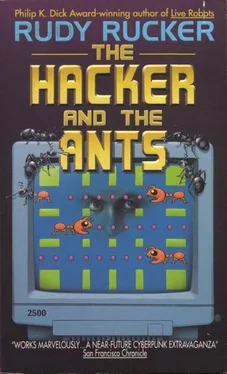Rudy Rucker - The hacker and the ants
Здесь есть возможность читать онлайн «Rudy Rucker - The hacker and the ants» весь текст электронной книги совершенно бесплатно (целиком полную версию без сокращений). В некоторых случаях можно слушать аудио, скачать через торрент в формате fb2 и присутствует краткое содержание. Жанр: Киберпанк, на английском языке. Описание произведения, (предисловие) а так же отзывы посетителей доступны на портале библиотеки ЛибКат.
- Название:The hacker and the ants
- Автор:
- Жанр:
- Год:неизвестен
- ISBN:нет данных
- Рейтинг книги:4 / 5. Голосов: 1
-
Избранное:Добавить в избранное
- Отзывы:
-
Ваша оценка:
- 80
- 1
- 2
- 3
- 4
- 5
The hacker and the ants: краткое содержание, описание и аннотация
Предлагаем к чтению аннотацию, описание, краткое содержание или предисловие (зависит от того, что написал сам автор книги «The hacker and the ants»). Если вы не нашли необходимую информацию о книге — напишите в комментариях, мы постараемся отыскать её.
The hacker and the ants — читать онлайн бесплатно полную книгу (весь текст) целиком
Ниже представлен текст книги, разбитый по страницам. Система сохранения места последней прочитанной страницы, позволяет с удобством читать онлайн бесплатно книгу «The hacker and the ants», без необходимости каждый раз заново искать на чём Вы остановились. Поставьте закладку, и сможете в любой момент перейти на страницу, на которой закончили чтение.
Интервал:
Закладка:
The tuxedo I used was pretty routine; it showed me wearing what I usually wore in real life, which was sandals, patterned socks, shorts, and a California sport shirt. I could change the patterns of the fabrics of my socks and shirt, and if I wanted to, I could get new simmie clothes, or I could even turn my clothes off entirely. The nude version of my tuxedo allowed me the option of deciding whether or not my simmie-genitals should show. In any case, the face was the important part. I had a series of canned expression shots; Dirk’s assistant had spent the better part of two hours coaching me into convincing expressions of laughter, surprise, boredom, anger, grief, etc. For casual communication, my software would guess at my expression from the sound of my voice. For higher-bandwidth communication, there was a pencil-sized video camera on my computer which could map realtime images of my face onto my tuxedo’s head.
I came into the GoMotion reception area wearing an expression of controlled worry. The tuxedo of Leonard, the tech group secretary, looked up at me and activated a roguish-smile expression. Leonard had a damp mustache and a perpetual sunburn. His virtual office was a big loft with clean white walls and skylights showing fluffy clouds overhead. A simmie of Bengt, our virtual prototype for Studly’s successor, was purring back and forth, pushing a polisher across the parquet floor. Bengt’s neck was a bit longer than Studly’s, and his body box had a slimmer shape. But for his legs he used the same inspired wheels-on-legs hack as Studly.
“Hi, Jerzy,” said Leonard.
“Hi, Leonard. Say, I think some of our ants got loose. Has anyone else noticed?”
Leonard laughed merrily. In his tux laugh loop, he would always touch his tongue to his mustache at the right corner of his mouth, a tic which made him seem both puppyish and devil-may-care.
“Why don’t you ask your bad rogue ant for some ID? Dereference a pointer or something.”
“When I picked it up, it bit me,” I explained. Leonard laughed the more wildly.
“It’s not funny, Leonard. If the ant is eating and shitting and leaving trails, all my code is being corrupted. It’s a wonder I can still see.”
“I’d think you’d be proud of yourself. Roger’s been promising us live ante for years, and now that you’ve been working with him, one of his ants has finally gotten smart enough to break out. Isn’t that a good thing, Jerzy?”
“Is Roger here?”
“He’s been in and out all weekend. Maybe he e-mailed you the ant!”
“Maybe.” Sending an experimental artificial life-form out over the electronic mail Net would be an incredibly careless thing to do, but not wholly out of character for Roger Coolidge. He was a genius-level computer hacker, somewhat eccentric, and imbued with the self-confidence that came from having founded a Silicon Valley startup that had mushroomed to a billion dollars in revenue in six short years. It was an honor for me to get to work so closely with him. Sometimes it was also a pain in the neck.
I sighed, and my computer transmitted my sigh from my microphone to Leonard’s receiver, wherever Leonard really was. Often he was physically at the GoMotion office in Sunnyvale, but several days a week he worked from his apartment down on Market Street in San Francisco. Maybe instead of wearing the gloves and the headset, he was watching me on a digital TV set, talking to me over a telephone, and moving his simmie with a video game joystick. For all I knew, looking at Leonard’s brightly cheerful cyberspace simulacrum, he was spending the day in bed with a lover. It was no use speculating. “How’s Bengt been doing? Has he banged into the furniture?”
“No. He’s smarter than Studly. Look.” Leonard scooped a handful of paper clips off his desk and threw them out in front of Bengt. GoMotion had modeled the laws of physics into Leonard’s office, so the little paper clip simmies flew along naturalistic parabolas, bounced on the woodgrain-patterned floor, and skidded to rest.
Bengt had been down on all four wheels pushing his floor buffer, but now he rose up into an alert crouch, balancing easily on his flexed legs. After carefully looking around the room, Bengt wheeled over to stop a few inches from the nearest paper clip and unfolded his pincer-clamp manipulator. Delicately he tweezered up the paper clip and put it in a drawer in his chest. Moving with no wasted motions, Bengt worked his way around the room to pick up all the paper clips before he resumed buffing the floor. The less efficient Studly would have dealt with the paper clips in a one-by-one, piecemeal fashion as his floor polisher bumped into them.
“Right on,” I said. “The improvements are thanks to genetic algorithms and artificial life, Leonard. I think Bengt’s ready for Our American Home.”
After one of our personal robot models could negotiate Leonard’s virtual office, we liked to test it in a full-size simmie-house that we called Our American Home. We had simmies of a family who supposedly lived there: clumsy Walt and Perky Pat Christensen, with son Dexter and daughter Baby Scooter. They all had blond hair and texture-mapped tan skin, and they all bothered the robots in different ways.
Dexter liked to play pranks. He’d tip a robot over onto its back and drag it to the head of the stairs with a blanket over its head. Perky Pat would give the robots contradictory commands, “Now follow me, and stay right where you are. Hurry, dammit!” Baby Scooter was a sullen blob who would nap on the floor, waiting to see if a robot would bump her or nip her so she could scream bloody murder. Sometimes Walt got “drunk,” and Perky Pat got “totally wired,” and they would lurch and spazz around, doing their best to trip over the increasingly wary robot simmie.
The tests in Our American Home were crucial, as the possibility of personal robots injuring someone was the A-number-one factor that had kept them off the open market in the past. Although if there were accidents, GoMotion’s position would be that they were only selling kits and software for the Veep robots-rather than the completed Veeps themselves. If your robot screwed up, it was your fault for having built it. So far this type of defense had held up against people whose Iron Camels had crashed. Our kits came with “no explicit or implied warranty of merchantibility or fitness for a particular purpose.” Even so, the Veeps had to be very safe and very good if they were going to sell well.
My work at GoMotion was to try and use artificial life evolution techniques to improve the programs that controlled the Veep. Once we had the specs for a new prototype, instead of actually building it out of wires and metal, we would generate a simmie of the thing and test it out in cyberspace. Roger Coolidge had been one of the first fully to exploit this great corner-cutting trick. He had used it to design the Iron Camel. Being something of a bullshit artist, in the most Midwestern kind of way, Roger had dubbed his trick “cybercad.”
CAD stood for computer aided design; most architects and engineers were using CAD instead of drafting tools. The idea behind CAD was to draw a three-dimensional computer graphical model of, say, a fan blade before you built it. Someone gave you a blueprint for a fan blade and you made a digital data base which in some sense was the blade. You could generate graphic views of it from every angle, zoom in on its details, take cross sections of it, calculate its weight and volume, etc. Cybercad meant pushing all this a little farther; in cybercad you could pump in virtual air, spin the blade, and measure the net blowage.
The funny thing about the “cyber” prefix was that it had always meant bullshit.
Back in the 1940s, the story went, MIT doubledome Norbert Wiener had wanted a title for a book he’d written about the electronic control of machines. Claude Shannon, also known as The Father Of Information Theory, told Wiener to call his book Cybernetics. The academic justification for the word was that the “cyber” root came from the Greek word for “rudder.” A “kybernetes” was a steersman, or, by extension, a mechanical governor such as a weight-and-pulley feedback device you might hook to your tiller to keep your sailboat aimed at some fixed angle into the wind. The practical justification for the word was contained in Shannon’s advice to Wiener: “Use the word ‘cybernetics,’ Norbert, because nobody knows what it means. This will always put you at an advantage in arguments.”
Читать дальшеИнтервал:
Закладка:
Похожие книги на «The hacker and the ants»
Представляем Вашему вниманию похожие книги на «The hacker and the ants» списком для выбора. Мы отобрали схожую по названию и смыслу литературу в надежде предоставить читателям больше вариантов отыскать новые, интересные, ещё непрочитанные произведения.
Обсуждение, отзывы о книге «The hacker and the ants» и просто собственные мнения читателей. Оставьте ваши комментарии, напишите, что Вы думаете о произведении, его смысле или главных героях. Укажите что конкретно понравилось, а что нет, и почему Вы так считаете.












